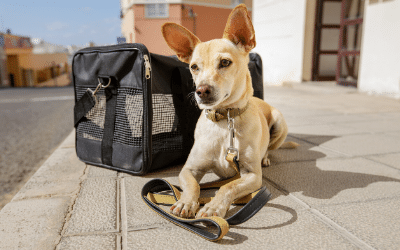Hitting the road soon? Winnebago County Animal Services has a few tips to ensure safe travels on your upcoming trip. Whether you and your pets decide to go on a short exploration or a grand adventure, it’s important to keep safety the number one priority.
Traveling By Vehicle
- Properly secure your pet. If your pet is riding in a carrier, make sure the carrier cannot shift or slide around when he moves or when the car comes to an abrupt stop. If your pet isn’t traveling in his carrier, be sure he is properly fastened in a well-fitting harness and seat belt.
- Bring pet-ownership necessities. Food, treats, bottled water, bowls, waste bags, leash, grooming supplies, medications, and a first aid kit are the basic items you should bring. It’s also a good idea to bring your pet’s favorite toy or blanket to help them feel more at home. Depending on where you’re traveling, you may also need your pet’s vaccination records — specifically rabies — as some places require proof of vaccinations.
- Make scheduled stops. Humans aren’t the only ones who get restless after being in a car too long. Taking a break every few hours will allow you and your pet to stretch, use the bathroom, and burn off some energy.
- Never leave your pet in a non-running vehicle. When it’s hot outside, a car’s interior can quickly rise to dangerous temperatures that can cause dehydration, heat stroke, and death — even with the windows rolled down. When it’s cold outside, your car’s interior can plummet to freezing temperatures, which can cause frostbite and death.
Traveling By Airplane
- Prior to booking a flight, review and compare airline rules and regulations regarding pet travel. You’ll want to choose an airline that will be the best for you and your pet’s needs. Depending on the airline, smaller pets may be allowed to be with you in the cabin with the appropriate sized carrier.
- Obtain a health certificate from your veterinarian. Airlines require proof of vaccinations for all animals on board. Health certificates are generally only accepted within 10 days of your departure, so be sure to schedule accordingly. If you suspect your pet will become anxious during the flight, discuss pet calming aids with your veterinarian.
- If possible, book a direct flight. Flying can cause stress to your pet, so the fewer times your pet is moved on and off the plane, the better.
Regardless of how you travel, make sure your pet is wearing a collar and tag with his name and your contact information. This is also a good time to make sure your information connected to your pet’s microchip is updated. Taking these precautions will mean a higher chance of being reunited with your pet if something unexpected was to happen.
Source: ARL – Animal Rescue League of Iowa, Inc. 2018 – https://www.arl-iowa.org/
